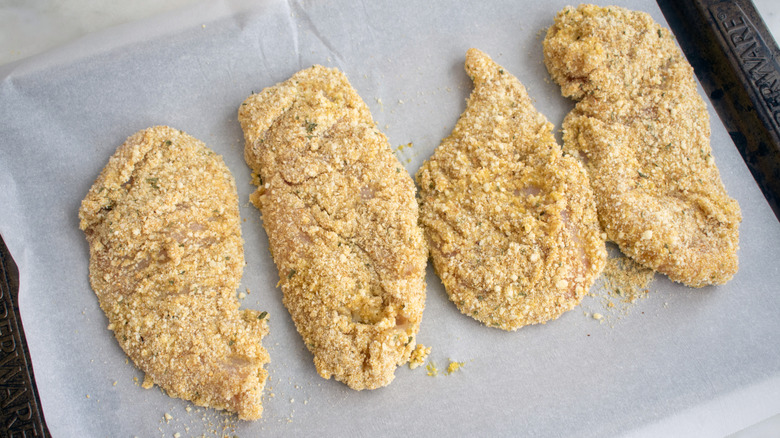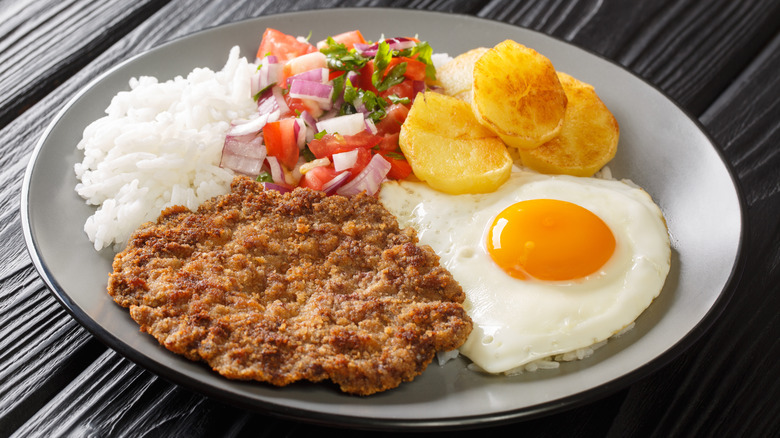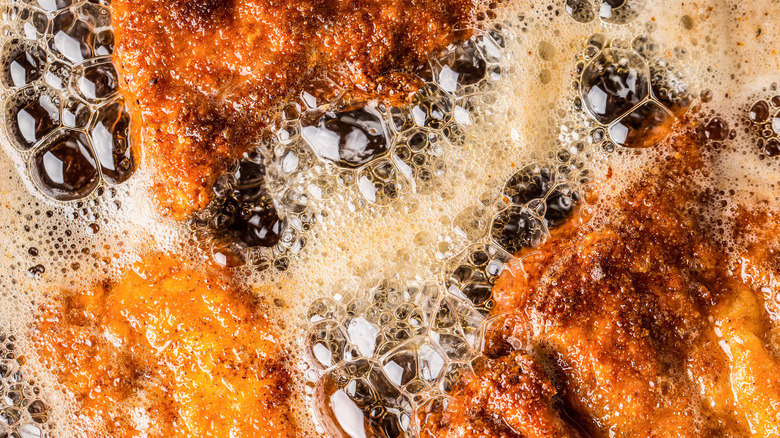The Unique Cutlet-Breading Technique That Challenges Everything You Thought You Knew
Breaded and fried dishes have a special place in our foodie hearts. They're a crispy comfort food and a wonderful way to stretch your ingredients. They pop up around the world: in the American South, there's chicken-fried steak and fried green tomatoes; in Europe, you'll find croquettes and various forms of schnitzel; and Japanese shrimp tempura and katsu dishes utilize the panko-swaddled protein. Many popular recipes for fish, chicken, and pork chops involve dredging the meat in some kind of coating or a batter bath before deep-frying.
But as delicious as these preparations are, they're hard to execute perfectly. A lot can happen with a mess of wet and dry ingredients, raw meat, and hot oil, and there's always the risk of overcooking the meat or having its carefully crafted coating crumble off. Breadcrumbs are handy for using up stale bread, crackers, and the like, but they're less forgiving than batter, which at least has the decency to cover your food evenly after dipping. Fortunately, a Bolivian dish called silpancho will change the way you look at cooking cutlets.
Omit the flour and egg
Silpancho (meaning "flat and thin," per Travel Food Atlas) involves a very thinly rolled-out, breaded cutlet, but what sets it apart is that many cooks fry it without dipping it in egg first. Instead, it's only thoroughly smushed into a bowl of breadcrumbs before it hits the hot oil. There's no goopy batter, no flour or egg everywhere, and no caked fingertips — just a perfectly crispy cutlet served with fried eggs, potatoes, rice, fresh vegetables, and spicy salsa. This technique even works for breading ground meat. Yes, that's a thing — a wonderful thing!
According to the blog Bolivian Cookbook, you can also break lean ground meat (like beef or bison) into golf ball-sized orbs, roll them in seasoned breadcrumbs, and then flatten out the meat with a rolling pin, flipping the meat and repeating the coating and rolling until you've formed a cutlet with the thickness of a crepe. Bolivian Cookbook says to sear the cutlets in a skillet on medium-high, turning them over just when browning begins.
Breading and beyond
There are a few reasons why this method works in the absence of egg or flour. Normally, those ingredients would be used to get the breading to stick to the meat, but here, you have such a thin, uniform piece of meat that you don't need to worry about errant batter chunks like you would on, say, pieces of fried chicken, or floppy, odd-sized fried vegetables. As Inside the Rustic Kitchen explains, it creates a light coating that doesn't bog down your meat — and in the author's case, it's an old Italian secret passed down and certainly worthy of adding to any cook's repertoire.
For further convenience when making breaded cutlets, follow Just One Cookbook's advice and lightly oil your hands before handling meat, get the air out of the mixture by tossing it from hand to hand, and chill your meat in the fridge for up to an hour to make it easier to shape. Now that you've been schooled by silpancho, why not try recipes like Food Network's keto-breaded chicken cutlets or a perfectly golden Wiener schnitzel? You can try this technique out with a wide variety of flash-fried foods (via Livestrong); just be sure to choose a high smoke point oil. Fried and breaded foods are well within your reach — and no longer dirty your entire kitchen before they arrive on your plate.


